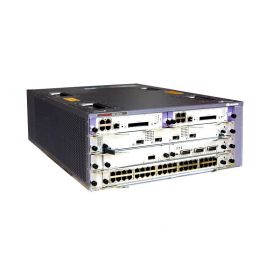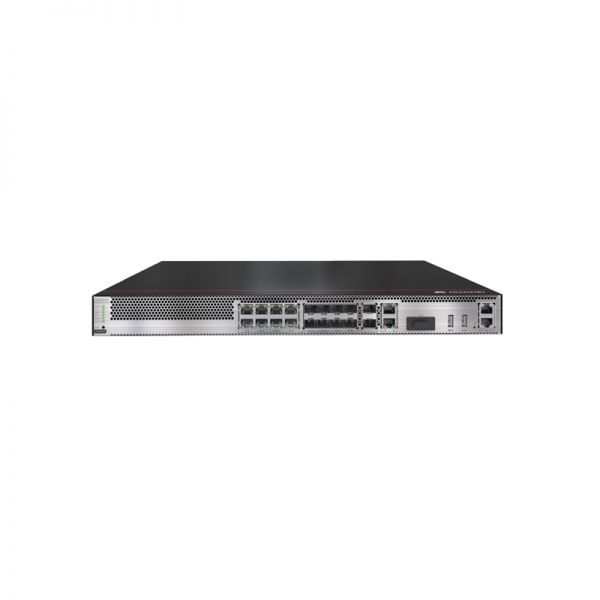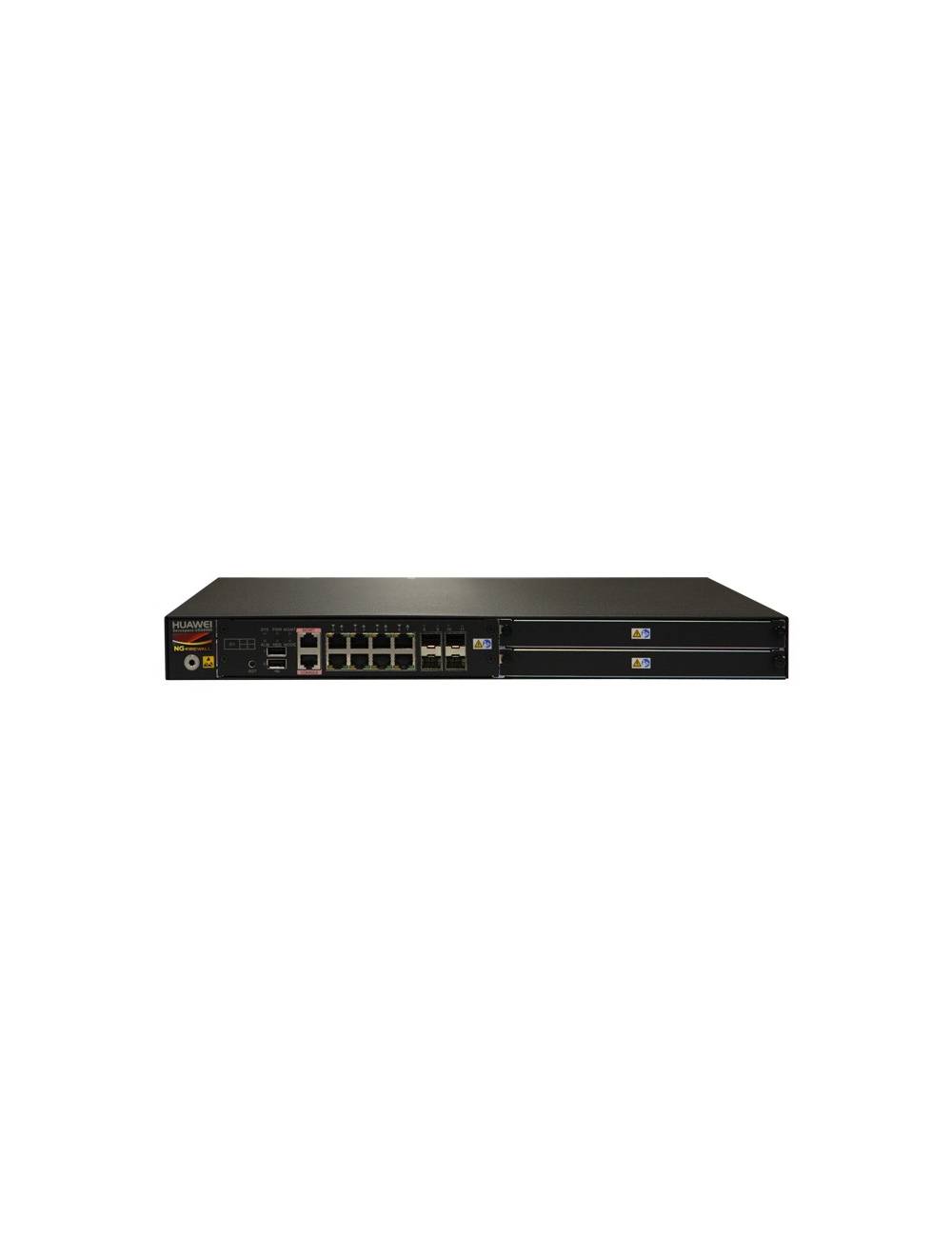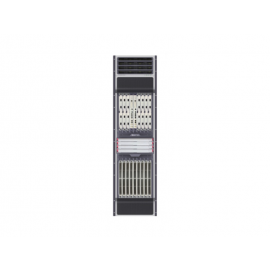Huawei NetEngine40E Series Universal Service Router CR5P03BASA72 Basic Configuration includes NE40E-X3 Chassis, 2 MPUs, 2 * 2200W AC Power supplies, without Software Charge and Document. The Huawei CR5P03BASA72 can be applied to the large-capacity core and edge network for data centers or large enterprises to meet the very - high level of bandwidth requirement, such as video conferencing, desktop cloud, and video surveillance applications or server virtualization, cloud computing and fabric consolidation in data center environments.
The NE40E-X3 CR5P03BASA72 router can be deployed as end to end 40G solution. 40G Ethernet is becoming irreversible trend in the enterprise market. 10G still uses in campus and datacenters, but to be preparing for the future, the enterprise need to have the plan to have the 40G deployment to grow to improve the efficiency. According to the reliability, NE40E provides a multi-level reliability solution that completely meets the reliability requirements of different services. It lays the foundation for enterprise services with a system availability of 99.999%.
Quick Specs
Figure 1 shows the appearance of Huawei Router - CR5P03BASA72.

Table 1 shows the Quick Specs.
|
Product Code |
Huawei Router - CR5P03BASA72 |
|
Switching Capacity |
1.08 Tbit/s |
|
Forwarding Performance |
540 Mpps |
|
MPU Slots |
2 |
|
SFU Slots |
none |
|
LPU Slots |
3 |
|
Service Card Slots |
Maximum 12 |
|
Weight |
52 kg (AC) |
|
Dimensions (W x D x H) |
220 mm x 442 mm x 650 mm (AC 5U) |
The Optical transceiver
Table 2 shows the recommended elements for the Huawei Router - CR5P03BASA72.
|
Model |
Description |
|
FE-SFP Optical Transceiver |
|
|
SFP,100M/155M,Multi-mode Module(1310nm,2km,LC) |
|
|
eSFP,100M/155M,Single-mode Module(1310nm,15km,LC) |
|
|
eSFP,FE,Single-mode Module(1310nm,40km,LC) |
|
|
GE-SFP Optical Transceiver |
|
|
SFP,GE,Electrical Interface Module(100m,RJ45) |
|
|
eSFP,GE,Multi-mode Module(850nm,0.55km,LC) |
|
|
eSFP,GE,Single-mode Module(1310nm,10km,LC) |
|
|
eSFP,GE,Single-mode Module(1310nm,40km,LC) |
|
|
eSFP,GE,Single-mode Module(1550nm,40km,LC) |
|
Compare to Similar Items
Table 3 shows the comparison between CR5P03BASA72 and CR5P08BASA71.
|
Model |
CR5P03BASA72 |
|
|
Switching Capacity |
1.08 Tbit/s |
7.08 Tbit/s |
|
Forwarding Performance |
540 Mpps |
2,880 Mpps |
|
MPU Slots |
2 |
2 |
|
SFU Slots |
none |
1 |
|
LPU Slots |
3 |
8 |
|
Service Card Slots |
Maximum 12 |
Maximum 32 |
|
Dimensions (W x D x H) |
220 mm x 442 mm x 650 mm (AC 5U) |
620 mm x 442 mm x 650 mm (14U) |
Huawei NE40E-X3 with 2*MPUs, 2*AC Power (CR5P03BASA72) Specification
CR5P03BASA72 Specification |
|
|
Switching Capacity |
1.08 Tbit/s |
|
Forwarding Performance |
360 Mpps |
|
Number of Slots |
5 slots (for 3 LPUs and 2 MPUs) |
|
Dimensions (W x D x H) |
442 mm x 650 mm x 220 mm (AC, 5U) |
|
Power Consumption (in full configuration) |
1,070W (AC) |
|
Weight (in full configuration) |
52 kg (AC) |
|
Interface Types |
100 GE/40 GE 10 GE- LAN/WAN GE/FE OC-192c/STM-64c POS OC-48c/STM-16c POS OC-12c/STM-4c POS OC-3c/STM-1cPOS Channelized OC-3/STM-1 Channelized STM-4 OC-3c/STM-1c ATM OC-12c/STM-4c ATM E3/T3 CE1/CT1 |
|
IPv4 |
Support for static routing as well as dynamic routing protocols, such as RIP, OSPF, IS-IS, and BGP-4 Line rate forwarding on all interfaces in complex routing environments, for example, when route flapping occurs |
|
IPv6 |
Various IPv4-to-IPv6 transition technologies: manual tunnel, automatic tunnel, 6to4 tunnel, GRE tunnel, and ISATAP tunnel IPv4 over IPv6 tunnel and IPv6 Provider Edge (6PE) IPv6 static routes and dynamic routing protocols, such as BGP4+, RIPng, OSPFv3, and IS-ISv6 IPv6 neighbor discovery, PMTU discovery, TCP6, ping IPv6, tracert IPv6, socket IPv6, static IPv6 DNS, IPv6 DNS server, TFTP IPv6 client, and IPv6 policy-based routing Internet Control Message Protocol Version 6 (ICMPv6), Management Information Base (MIB), User Datagram Protocol Version 6 (UDP6) MIB, TCP6 MIB, and IPv6 MIB L2NAT, NAT444, DS-Lite, and NAT64 |
|
MPLS |
MPLS TE and MPLS/BGP VPN, in compliance with RFC 2547 Inter-AS VPN Option A/B/C Integration with Internet services Martini and Kompella MPLS L2VPN L2VPN techniques, such as VPLS and VLL IP interworking over heterogeneous media Multicast VPN MPLS-TP, EVPN, Remote LFA |
|
Layer 2 Features |
IEEE 802.1Q, IEEE802.1ad, IEEE 802.1D, IEEE 802.1w, and IEEE 802.1s VLAN aggregation (super VLAN) Filtering list based on MAC addresses and ports 1483B |
|
Reliability |
IP/LDP/VPN/TE/VLL FRR Protection mechanisms such as IP/TE auto rerouting, IGP/BGP/multicast route convergence, VRRP, RRPP, IP-Trunk load balancing and backup, BFD, MPLS/Ethernet OAM, Y.1731, and routing protocol/port/VLAN damping PW redundancy, E-Trunk, E-APS, and E-STP In-service patching for smooth software upgrade Passive backplane design Redundancy backup for key components, such as route processing modules, SFUs, and power modules to guard against single points of failure Switching between components that hot-back up each other GR, NSF, NSR, and ISSU Hot swap of all components |
|
QoS |
Well-designed HQoS and advanced scheduling and congestion avoidance technologies on each LPU Accurate traffic policing and traffic shaping Complex rule definition and fine-grained flow identification MPLS H-QoS, ensuring QoS for MPLS VPN, VLL, and PWE3 services 8CT that combines MPLS TE and the DiffServ model TE-tunnel-oriented QoS |
|
OAM |
Y.1731, IP FPM, RFC 2544, MPLS OAM, 802.1ag, and 802.3ah, OPS |
|
Multicast |
IGMPv1, IGMPv2, and IGMPv3 Multicast routing protocols, including PIM-DM, PIM-SM, PIM-SSM, Multicast Source Discovery Protocol (MSDP), and Multiprotocol BGP (MBGP) Static multicast Multicast CAC Interoperability between multicast protocols Processing of multicast policies based on multicast routing protocols and multicast forwarding Multicast QoS and multicast replication for IPoE access users Two-level multicast replication on the SFUs and LPUs to optimize the multicast effect |
|
Security |
ACL-based packet filtering URPF GTSM DHCP snooping ARP attack defense and DoS attack defense MAC address limit and MAC-IP binding Secure Shell (SSH) and SSH version 2 (SSH v2) BGP-Flowspec RIPv2, OSPF, IS-IS, and BGP MD5, SHA256, Keychain |
|
Value-added Services |
IPsec tunnel Distributed GRE tunnel Distributed NetStream High-precision NAT: CGN |
|
Environment Requirements |
Long-term operating temperature: 0°C to 45°C Short-term operating temperature: -5°C to 55°C Long-term operating humidity: 5% RH to 85% RH Short-term operating humidity: 0% RH to 100% RH Operating altitude: ≤ 3,000 meters |








Customer questions & answers
Customer reviews
0 out of 5
No reviews yet